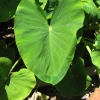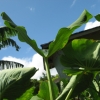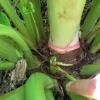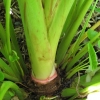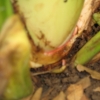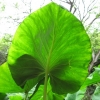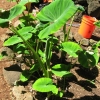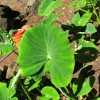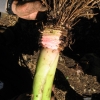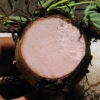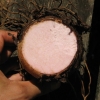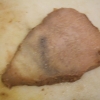Use As Food
A very important poi taro, particularly on Oahu. Goup piko are known to make good poi.
Distribution
Widely planted on all the islands, almost exclusively in lo‘i (wetland patches). The variety also appears to thrive up toward the mountains where the water is cooler.
General Characteristics
Medium in height, erect, moderately stocky, maturing within 15 to 18 months, producing from 5 to 10 ‘ohā: distinguished by light green Hā (Petiole) and pinkish kōhina (base).
Ha (Petiole)
60 to 100 cm. long, light green, pinkish-red at edge, usually with adjacent dark green blotches especially near kōhina (base), a pink ring at kōhina (base) with light pink for 3 to 4 cm. above.
Lau or Lu'au(Leaf Blade)
30 to 45 cm. long, 25 to 35 cm. wide, 20 to 35 cm from tip to base of sinus (māwae), egg-shaped (ovate), nearly horizontal, light to dark green; piko whitish; round leaf section (lobes) narrow and obtuse with narrow lihi māwae (sinus).
'I'o kalo (Corm)
Flesh white with pinkish apex and yellowish fibers; skin pale pink.
Pua (Flower)
H& #257; (peduncle) green; flower cover (spathe) 15 to 21 cm., long, the lower tubular constricted portion 3 to 4.5 cm. long, green, usually tinged with red at kōhina (base), usually partially opened exposing ovaries, the upper portion deep yellow 4 cm long, the sterile appendage (tip of flower's spike) about 4 mm. long.
Remarks
The ‘i‘o kalo (Corm) have fairly firm texture and will absorb more water, in the preparation of pa‘i‘ai, (freshly pounded cooked kalo) than most varieties. The poi is light bluish-grey in color and of very good quality. 18. Piko Kea and 19. Piko Ke‘oke‘o are similar in appearance. The difference is Piko Kea's kōhina (ring at base of petiole) is pink and the Piko Ke‘oke‘o's kōhina is white. We call these two sisters because they both have light green Hā (Petiole).

